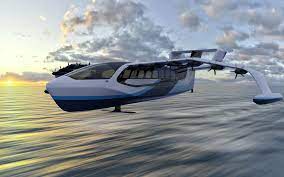
Complementary to the investment in “hoverbike” drones and robot mules, the famous USMC Warfighting Lab has signed a nearly $5 million contract to test out hydro-foiling sea gliders, which may provide an innovative solution for emergency resupply and medical transport in austere and isolated regions such those in the Indo-Pacific area.
The revolutionary idea of a “flying ferry” in support of the EABO will be developed by Regent, a Rhode Island-based company developing all-electric gliders for defense and commercial use. The glider is a boat-aircraft hybrid based on the hydro foiling principle, which allows the body of the glider to stay “airborne” at a short distance above the water’s surface, while the foils (or wings) stay in the water, pushing it down and generating an upward force in reaction to downward pressure.
In accordance with some US open sources, Regent’s sea glider model which will go under the tests is the 12-seat VICEROY. It can travel up to 180+ miles on a single charge, even if the CEO of Regent, Bill Thalheimer, has declared that the objective is to reach 500 miles soon. The prototype should weigh 6.800 kg, handle a payload of 1.587 kg, and have a 19,2 m wingspan. Its expected low price - under $5 million - should effectively address the recognized USMC (US DOD) gap for “high-speed, low-cost, low-signature, runway-independent mobility in the littorals, potentially unmanned, and fulfill a range of mission sets including troop and cargo transport, expeditionary advanced base operations, and communications,” as announced by Regent.
The Warfighting Lab, Thalheimer announced, will be conducting separate tests: a float demo, and then a hydrofoil, and a flight one with a culminating live technical demonstration of the full-scale prototype during a large-scale exercise. USMC has not confirmed any acquisition at this stage, however, in accordance with Thalheimer, its investment will allow the maturation of the technology and the validation of the concept. Thanks to its unlimited loiter time, and the possibility to land and take off in the water, the VICEROY could also serve as an intelligence, surveillance, and reconnaissance platform or an ad hoc communications network platform when equipped with the right payload.
The positive outcome of the test serials could potentially generate the interest of other US services, agencies, and foreign countries as well.








.png)
.gif)